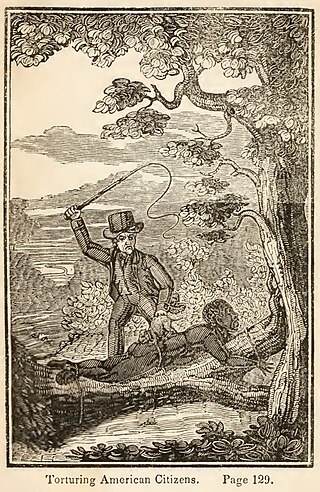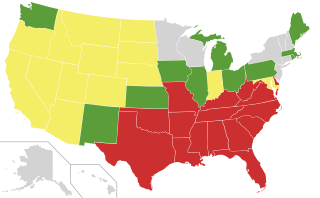Black is a racialized classification of people, usually a political and skin color-based category for specific populations with a mid- to dark brown complexion. Not all people considered "black" have dark skin; in certain countries, often in socially based systems of racial classification in the Western world, the term "black" is used to describe persons who are perceived as dark-skinned compared to other populations. It is most commonly used for people of sub-Saharan African ancestry, Indigenous Australians and Melanesians, though it has been applied in many contexts to other groups, and is no indicator of any close ancestral relationship whatsoever. Indigenous African societies do not use the term black as a racial identity outside of influences brought by Western cultures.
Mulatto is a racial classification that refers to people of mixed African and European ancestry only. When speaking or writing about a singular woman in English, the word is mulatta The use of this term began in the United States of America shortly after the Atlantic Slave Trade began and its use was widespread, derogatory and disrespectful. After the post Civil Rights Era, the term is now considered to be both outdated and offensive in America. In other Anglophone countries such as the British Isles, the Caribbean and English and Dutch-speaking West Indian countries, the word mulatto is still used. The use of this word does not have the same negative associations found among English speakers. Among Latinos in both the US and Latin America, the word is used in every day speech and it's meaning is a source of racial and ethnic pride. In four of the Latin-based languages, the default, masculine word ends with the letter "o" and is written as follows: Spanish and Portuguese – mulato; Italian – mulatto. The French equivalent is mulâtre. In English, the masculine plural is written as mulattoes while in Spanish and Portuguese it is mulatos. The masculine plural in Italian is mulatti and in French it is mulâtres. The feminine plurals are: English – mulattas; Spanish and Portuguese – mulatas; Italian – mulatte; French – mulâtresses.

The legal institution of human chattel slavery, comprising the enslavement primarily of Africans and African Americans, was prevalent in the United States of America from its founding in 1776 until 1865, predominantly in the South. Slavery was established throughout European colonization in the Americas. From 1526, during the early colonial period, it was practiced in what became Britain's colonies, including the Thirteen Colonies that formed the United States. Under the law, an enslaved person was treated as property that could be bought, sold, or given away. Slavery lasted in about half of U.S. states until abolition in 1865, and issues concerning slavery seeped into every aspect of national politics, economics, and social custom. In the decades after the end of Reconstruction in 1877, many of slavery's economic and social functions were continued through segregation, sharecropping, and convict leasing.
The one-drop rule was a legal principle of racial classification that was prominent in the 20th-century United States. It asserted that any person with even one ancestor of African ancestry is considered black. It is an example of hypodescent, the automatic assignment of children of a mixed union between different socioeconomic or ethnic groups to the group with the lower status, regardless of proportion of ancestry in different groups.
The Albert J. Beveridge Award is awarded by the American Historical Association (AHA) for the best English-language book on American history from 1492 to the present. It was established on a biennial basis in 1939 in memory of United States Senator Albert J. Beveridge (1862-1927) of Indiana, former secretary and longtime member of the Association, through a gift from his wife, Catherine Eddy Beveridge and donations from AHA members from his home state. The award has been given annually since 1945.

Edward Franklin Frazier, was an American sociologist and author, publishing as E. Franklin Frazier. His 1932 Ph.D. dissertation was published as a book titled The Negro Family in the United States (1939); it analyzed the historical forces that influenced the development of the African-American family from the time of slavery to the mid-1930s. The book was awarded the 1940 Anisfield-Wolf Book Award for the most significant work in the field of race relations. It was among the first sociological works on Black people researched and written by a black person.

The curse of Cain and the mark of Cain are phrases that originated in the story of Cain and Abel in the Book of Genesis. In the stories, if someone harmed Cain, the damage would come back sevenfold. Some interpretations view this as a physical mark, whereas other interpretations see the "mark" as a sign, and not as a physical mark on Cain himself. The King James Version of the Bible reads "set a mark upon Cain".
Neoabolitionist is a term used in historiography to characterize historians of race relations motivated by the spirit of racial equality typified by the abolitionists who fought to abolish slavery in the mid-19th century. They write especially about African-American history, slavery in the United States, the American Civil War and the Reconstruction Era.
Carl Neumann Degler was an American historian and Pulitzer Prize-winning author. He was the Margaret Byrne Professor of American History Emeritus at Stanford University.
Leon Frank Litwack was an American historian whose scholarship focused on slavery, the Reconstruction Era of the United States, and its aftermath into the 20th century. He won a National Book Award, the Pulitzer Prize for History, and the Francis Parkman Prize for his 1979 book Been In the Storm So Long: The Aftermath of Slavery. He also received a Guggenheim Fellowship.
Racial democracy is a concept that denies the existence of racism in Brazil. Some scholars of race relations in Brazil argue that the country has escaped racism and racial discrimination. Those researchers cite the fact that most Brazilians claim not to view others through the lens of race, and thus the idea of racial discrimination is irrelevant.

Race Matters is a social sciences book by Cornel West. The book was first published on April 1, 1993, by Beacon Press. The book analyzes moral authority and racial debates concerning skin color in the United States. The book questions matters of economics and politics, as well as ethical issues and spirituality, and also addresses the crisis in black American leadership.

Slave breeding was the practice in slave states of the United States of slave owners systematically forcing slaves to have children to increase their wealth. It included coerced sexual relations between enslaved men and women or girls, forced pregnancies of enslaved women and girls due to forced inter inbreeding with fellow slaves in hopes of producing relatively stronger future slaves. The objective was for slave owners to increase the number of people they enslaved without incurring the cost of purchase, and to fill labor shortages caused by the abolition of the Atlantic slave trade.

There is no single system of races or ethnicities that covers all modern Latin America, and usage of labels may vary substantially.

The sociology of race and ethnic relations is the study of social, political, and economic relations between races and ethnicities at all levels of society. This area encompasses the study of systemic racism, like residential segregation and other complex social processes between different racial and ethnic groups.

In the United States, many U.S. states historically had anti-miscegenation laws which prohibited interracial marriage and, in some states, interracial sexual relations. Some of these laws predated the establishment of the United States, and some dated to the later 17th or early 18th century, a century or more after the complete racialization of slavery. Nine states never enacted anti-miscegenation laws, and 25 states had repealed their laws by 1967. In that year, the U.S. Supreme Court ruled in Loving v. Virginia that such laws are unconstitutional under the Fourteenth Amendment to the U.S. Constitution.

Blanqueamiento in Spanish, or branqueamento in Portuguese, is a social, political, and economic practice used in many post-colonial countries in the Americas and Oceania to "improve the race" towards a supposed ideal of whiteness. The term blanqueamiento is rooted in Latin America and is used more or less synonymously with racial whitening. However, blanqueamiento can be considered in both the symbolic and biological sense. Symbolically, blanqueamiento represents an ideology that emerged from legacies of European colonialism, described by Anibal Quijano's theory of coloniality of power, which caters to white dominance in social hierarchies. Biologically, blanqueamiento is the process of whitening by marrying a lighter-skinned individual to produce lighter-skinned offspring.
Racism has been present in Brazil since its colonial period and is pointed as one of the major and most widespread types of discrimination, if not the most, in the country by several anthropologists, sociologists, jurists, historians and others. The myth of a racial democracy, a term originally coined by Brazilian sociologist Gilberto Freyre in his 1933 work Casa-Grande & Senzala, is used by many people in the country to deny or downplay the existence and the broad extension of racism in Brazil.

The treatment of slaves in the United States often included sexual abuse and rape, the denial of education, and punishments like whippings. Families were often split up by the sale of one or more members, usually never to see or hear of each other again.

Slavery in what became the U.S. state of Illinois existed for more than a century. Illinois did not become a state until 1818, but earlier regional systems of government had already established slavery. France introduced African slavery to the Illinois Country in the early eighteenth century. French and other inhabitants of Illinois continued the practice of owning slaves throughout the Illinois Country's period of British rule (1763–1783), as well as after its transfer to the new United States in 1783 as Illinois County, Virginia. The Northwest Ordinance (1787) banned slavery in Illinois and the rest of the Northwest Territory. Nonetheless, slavery remained a contentious issue, through the period when Illinois was part of the Indiana Territory and the Illinois Territory and some slaves remained in bondage after statehood until their gradual emancipation by the Illinois Supreme Court. Thus the history of slavery in Illinois covers several sometimes overlapping periods: French ; British ; Virginia ; United States Northwest Territory (1787–1800), Indiana Territory (1800–1809), Illinois Territory (1809–1818) and the State of Illinois.













